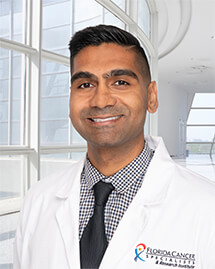High-Dose Once-Daily Thoracic Radiotherapy in Limited-Stage Small-Cell Lung Cancer: CALGB 30610 (Alliance)/RTOG 0538
Dr. Anjan Patel's Thoughts
Twice-Daily radiation therapy is a long-standing SOC for LS-SCLC based upon improved OS in Intergroup0096, published nearly 25 years ago in 1999. This study compared 45 Gy at 1.5 Gy/fx BID vs. 45 Gy at 1.8 Gy/day. This regimen, however, has been slow to be adopted due to the inconvenience of BID therapy, as well as the modest radiation dose in control arm.
The current study, along with the similarly conducted CONVERT trial (Lancet Oncol, 2017), establishes modern, dose-escalated QD radiation therapy (70 Gy) as non-inferior to BID treatment (45 Gy) without any significant differences in survival or toxicity. The lack of improvement in outcomes with dose-escalated RT remains perplexing to the radiation oncology community but provides evidence-based rationale to QD therapy with concurrent platinum + etoposide chemotherapy.
(Remarks from Radiation Oncologist Kunal Saigal, MD)
PURPOSE
Although level 1 evidence supports 45-Gy twice-daily radiotherapy as standard for limited-stage small-cell lung cancer, most patients receive higher-dose once-daily regimens in clinical practice. Whether increasing radiotherapy dose improves outcomes remains to be prospectively demonstrated.
METHODS
This phase III trial, CALGB 30610/RTOG 0538 (ClinicalTrials.gov identifier: NCT00632853), was conducted in two stages. In the first stage, patients with limited-stage disease were randomly assigned to receive 45-Gy twice-daily, 70-Gy once-daily, or 61.2-Gy concomitant-boost radiotherapy, starting with either the first or second (of four total) chemotherapy cycles. In the second stage, allocation to the 61.2-Gy arm was discontinued following planned interim toxicity analysis, and the study continued with two remaining arms. The primary end point was overall survival (OS) in the intention-to-treat population.
RESULTS
Trial accrual opened on March 15, 2008, and closed on December 1, 2019. All patients randomly assigned to 45-Gy twice-daily (n = 313) or 70-Gy once-daily radiotherapy (n = 325) are included in this analysis. After a median follow-up of 4.7 years, OS was not improved on the once-daily arm (hazard ratio for death, 0.94; 95% CI, 0.76 to 1.17; P = .594). Median survival is 28.5 months for twice-daily treatment, and 30.1 months for once-daily treatment, with 5-year OS of 29% and 32%, respectively. Treatment was tolerable, and the frequency of severe adverse events, including esophageal and pulmonary toxicity, was similar on both arms.
CONCLUSION
Although 45-Gy twice-daily radiotherapy remains the standard of care, this study provides the most robust information available to help guide the choice of thoracic radiotherapy regimen for patients with limited-stage small-cell lung cancer.
